What to do to start prepping for Thanksgiving now -- 3 weeks ahead
Thanksgiving is just 3 weeks away. We repeat: Thanksgiving is in 3 weeks! To help out with the most labor intensive, holiest of cooking holidays, we're giving you a Thanksgiving prep list, starting last week and continuing with what you can make (and freeze!) 3 weeks, 2 weeks, and 1 week ahead.
There are a lot of Thanksgiving dishes that will last in the freezer for several months, namely rolls, bread, biscuits, and stuffing.
Here's how to get started on them 3 weeks out:
Rolls
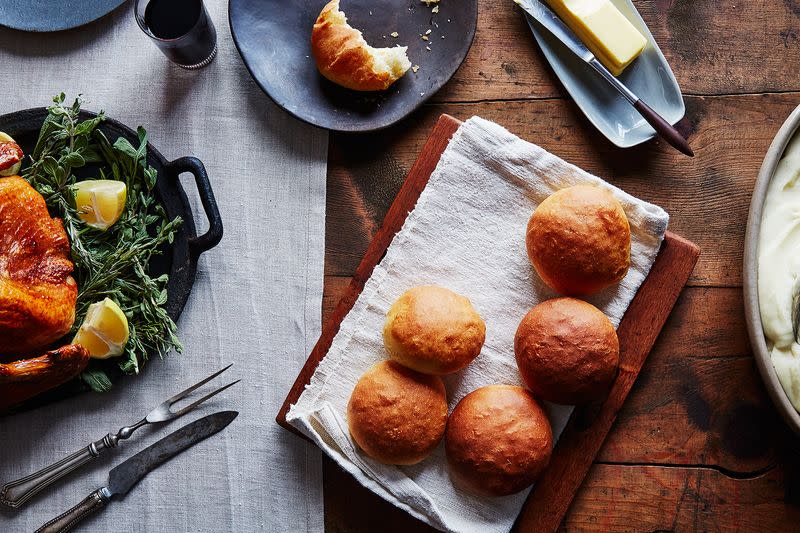
Here, you have two options: bake and then freeze or freeze un-baked and bake later.
For those who'd like to totally check rolls off of your Thanksgiving to-do list, baking and freezing is your best option. Bake your rolls as usual, then let cool completely and wrap in aluminum foil. Place in a freezer bag and freeze for up to a month. To thaw, take your rolls out of the freezer, make sure the foil's not too tight around the rolls, then thaw at room temperature overnight. You could eat them straight-away, but for a fresh baked feel, pop them into a 300°F oven for 10 to 15 minutes to warm through.
RELATED: 15 recipes that will put your Thanksgiving leftovers to good use
You can also freeze un-baked and bake later, you'll want to make your dough with cool water (or another liquid, like milk), so says King Arthur Flour's blog. This is to avoid activating the yeast for as long as possible, so it's less likely to become damaged when frozen. Their blog also recommends increasing the amount of yeast you use by 20%, as a sort of damage control.
As soon as your dough is fully-kneaded, shape your rolls straightway. You don't need to let it rise! Again, you want to activate the yeast as little as possible. Place your rolls on a parchment or wax paper-lined sheet pan, cover with plastic wrap, and freeze the rolls completely (we're talking rock hard), then remove from the sheet pan, and place into a freezer bag. The day you want to freeze and bake your rolls, remove the rolls from the freezer, space the rolls onto a lightly greased pan or baking sheet, cover with plastic wrap, and let thaw and rise for 4 to 5 hours. Once the rolls have risen, bake them as per usual! King Arthur's site recommends freezing rolls for up to 3 weeks—perfect!—as the cold will, eventually, kill the yeast, rendering the rolls' riseability null.
Yeasted Bread
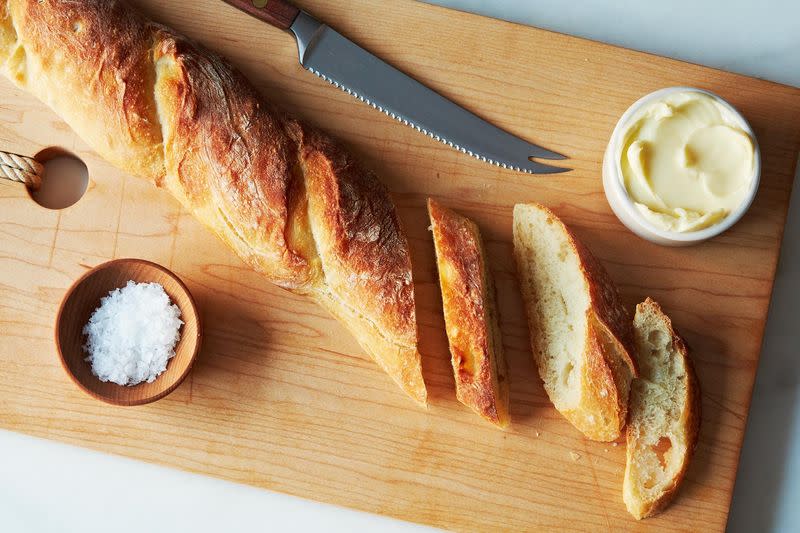
Like the rolls, there are two ways to freeze whole bread loaves. The first is freezing fully-baked bread. Make sure the bread is completely cool—wrapping hot bread will make it soggy upon reheating—and place it in a large freezer bag. If your loaf's too big to fit into a single bag (like a baguette), use two bags, sealing them tightly using freezer tape. To thaw bread, let it sit at room temperature for 3 to 4 hours and, to serve it hot, place in a 300°F oven for 10 to 15 minutes to warm through.
RELATED: Vegan recipes for Thanksgiving
The second option is to par-bake your loaves, then freeze. To do so, make your bread as normal, pop it into the oven at the temperature the recipe suggests, bake for 12 to 15 minutes, and remove from the oven. You want the bread to be set, but not completely brown. Let the bread cool completely before wrapping as instructed above and freezing. To bake, thaw the bread overnight in the fridge, wrapped, and bake at the bread's designated temperature until the loaf is browned, sounds hollow when turned over and tapped on the bottom, and/or has an internal temperature of 190°F to 200°F.
Stuffing
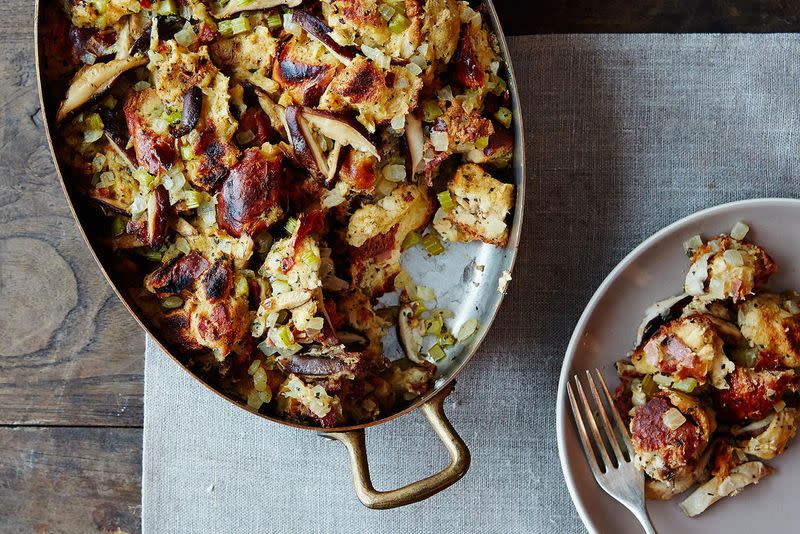
Our Hotline has some good stuffing freezing tips. First, make the stuffing (here, we're talking specifically about bread-based stuffing). Let it cool, then place into a freezer bag or bags. When ready to cook, thaw the stuffing in the fridge overnight. From here, our Hotline has a few suggestions: For a drier, fluffier stuffing, stir in a bit more toasted/dry bread or breadcrumbs to absorb any of the condensation released from defrosting, place it in a baking dish, cover with foil, and bake until it's as fluffy as when you first made it. For a more moist stuffing, thaw as mentioned, add a bit of extra broth, cover with foil and bake, remove the foil, and dot it with butter and place back in the oven to brown the top.
Cornbread
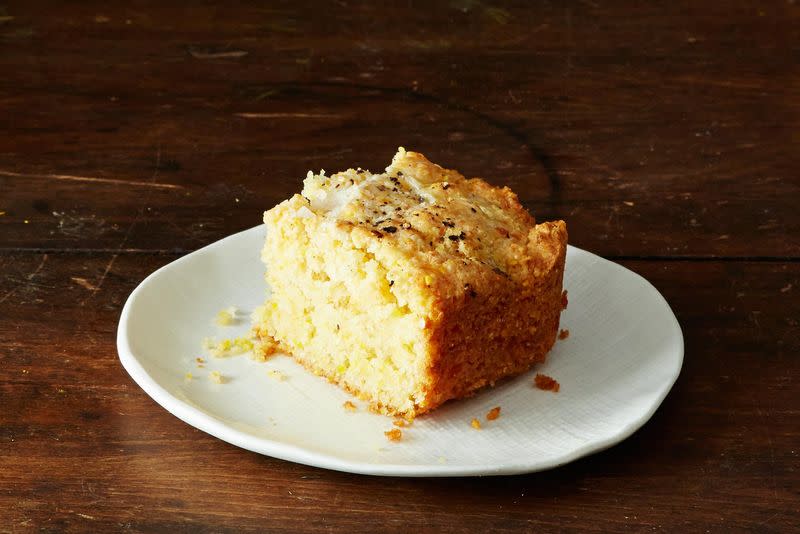
This is easy! Bake the cornbread as per your recipe's instructions and allow to cool completely. You can remove it from the pan and place it in a freezer bag whole, halved, whatever you like—or, if you baked the cornbread in a aluminum pan you can spare, just freeze it in the pan. Place the cornbread in large freezer bag (alternatively, wrap in plastic wrap, then wrap in aluminum foil, and seal with freezer tape), and freeze. To reheat, take out of the plastic bag, cover in foil, and place in a 300°F oven until warmed through. The cornbread might not be as moist after baking it a second time, but, hey it's still cornbread and you still saved time.
Biscuits
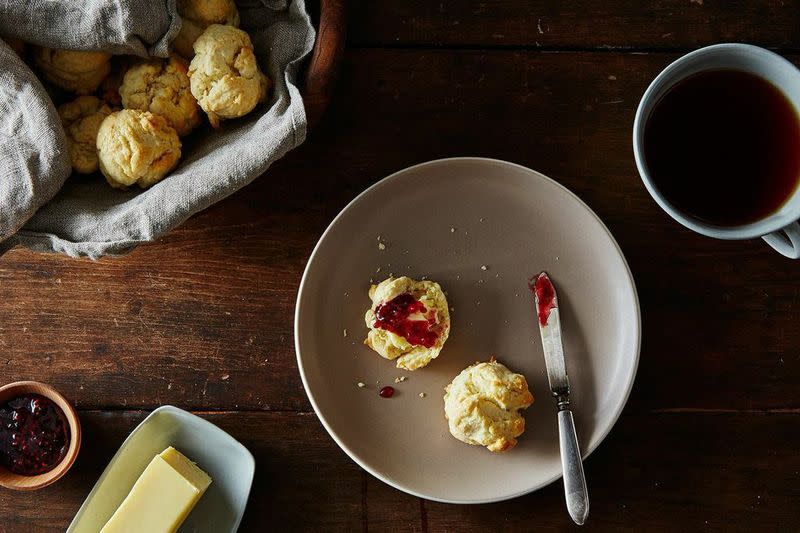
To freeze biscuits, follow the recipe's directions for mixing and shaping your dough, then place the un-baked biscuits on a parchment-lined baking sheet. Cover with plastic wrap and place in the freezer. Once the biscuits are fully-frozen, remove from the baking sheet and place into a freezer bag. When ready to bake, place (again) on a parchment-lined baking sheet and bake as normal—adding a few minutes onto the cook time to account for the biscuits having been frozen.
What do you make 3 weeks ahead of Thanksgiving? Let us know in the comments below!






